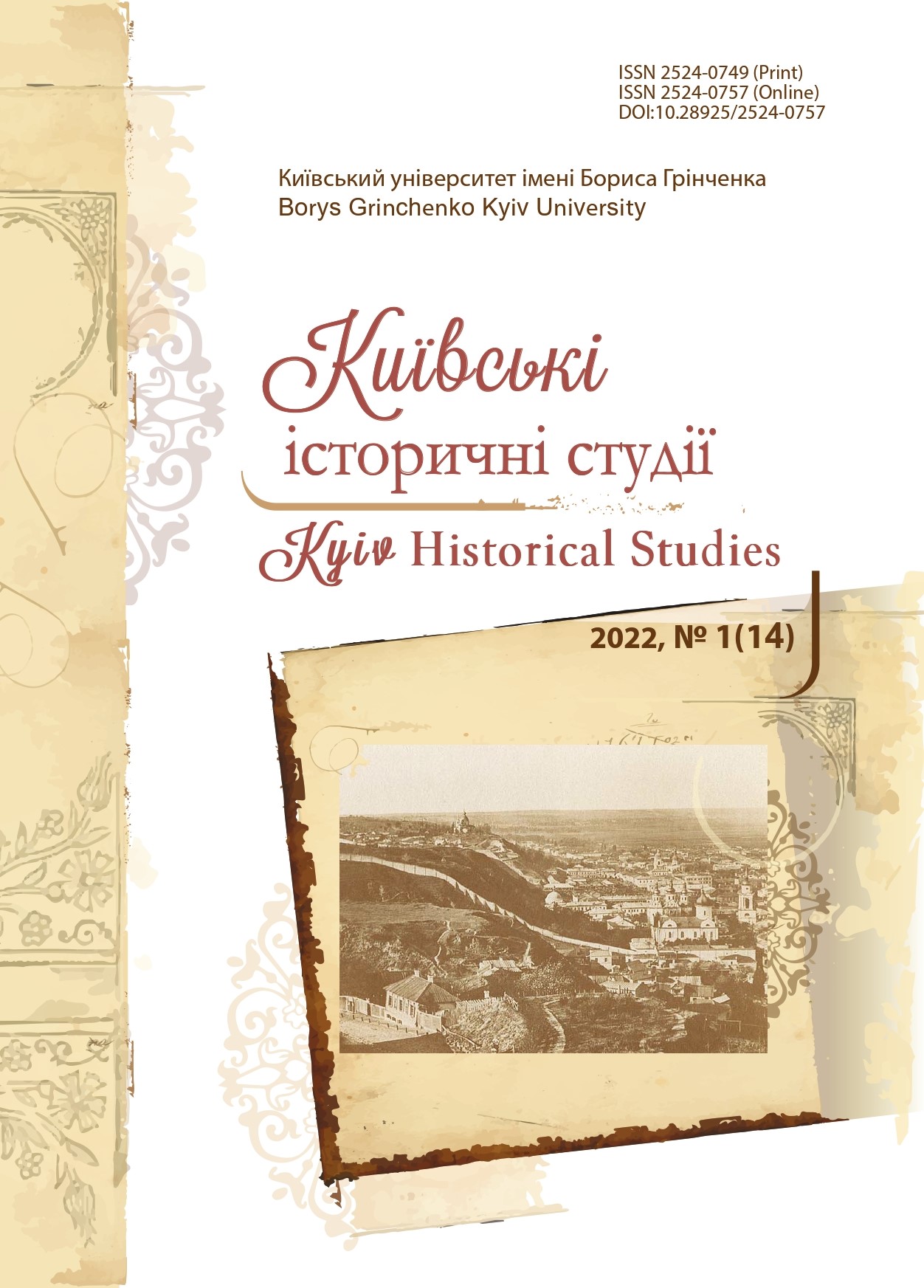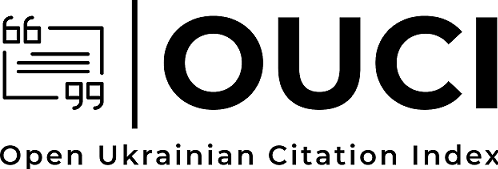On the History of the Cooperative Movement in POW Camp Wetzlar, Germany: The establishment and activity of the union «Chainia» (December 1915–1916)
DOI:
https://doi.org/10.28925/2524-0757.2022.13Keywords:
cooperative union, «Chainia», share, net profit, captured Ukrainian soldiers, Wetzlar, GermanyAbstract
The article highlights the specifics of the creation and activities in the camp of Ukrainian prisoners of war Wetzlar (Germany) of the «Chainia» Cooperative Society (December 1915–1916). From the very beginning of its work, «Chainia» offered its visitors low prices for food and provided a convenient opportunity to drink tea, which attracted a large number of campers. This in turn made «Chainia» a highly profitable enterprise (commercially), allowing it to make a significant profit. The income was distributed by the decision of the general meeting both on the payment of dividends on paid shares, and on the needs of various camp organizations and charitable support to the needy (including outside the camp). At the same time, the excessive influx of campers to «Chainia», the fierce debate on political issues and created some inconvenience for members of the cooperative. Some of the shareholders did not understand why campers with hostile or indifferent views to Ukrainians had the opportunity to use “all the amenities” and buy low-priced products in «Chainia». Therefore, from May 1916, the Tea House worked only for members of the cooperative, thus encouraging campers to join their ranks. Throughout its existence, «Chainia» remained an effective commercial enterprise, uniting prisoners of different political views and preferences. It made a significant contribution to the development of national life in the camp, effectively supporting the activities of educational courses and camp literacy schools and sponsoring funds for all-Ukrainian needs.
Downloads
References
Jung, I. & Wiedl, W. (2016). Ein “besonderes” Lager für Ukrainer Zwischen Propaganda und Alltagsnot. Wetzlar und der Erste Weltkrieg 1914–1918. Neustadt an der Aisch, pp. 262–282 [in German].
Kryvosheieva, L. M. (2005). Kooperatyvnyi rukh v taborakh viyskovopolonenykh ukraintsiv chasiv Pershoi svitovoi viyiny [Cooperative Movement in the Camps of Ukrainian Prisoners of War during the First World War]. Kulturolohichnyi visnyk, 15, 40–44 [in Ukrainian].
Kryvosheieva, L. M. (2009). Natsionalno-prosvitnia diialnist Soiuzu vyzvolennia Ukrainy v taborakh viiskovopolonenykh ukraintsiv (1914–1918 rr.) [National-Educational Activity of the Union of Liberation of Ukraine in the Camps of Ukrainian Prisoners of War (1914–1918)]. Candidate thesis, Zaporizhzhia [in Ukrainian].
Golczewski, F. (2010). Deutsche und Ukrainer: 1914–1939. Paderborn [in German].
Rehmer, C. (1994). Das Ukrainerlager Wetzlar-Büblingshausen (1915–1918). Ein besonderes Lager? Mitteilungen des Wetzlarer Geschichtsvereins, 37, 77–116 [in German].
Rehmer, C. (1997). “Revolutionierungspolitik” und Ukrainer-Lager Die Ukraine im Blickfeld deutscher Interessen. Ende des 19. Jahrhunderts bis 1917/18. Frankfurt a. M. u. a., 245–280 [in German]. Runzheimer, J. (1994). «...Damit alle an uns erinnert werden»! Das ukrainische Gefangenenlager in Wetzlar Heimat an Lahn und Dill, 284, 2–3 [in German].
Runzheimer, J. (2002). Film als historische Quelle. Das ukrainische Kriegsgefangenenlager in Wetzlar Claudia Weidemann und Rudolf Worschech: Kamera. Oskar Barnack. Frühe Filme aus Wetzlar und Umgebung, Frankfurt am Main, 25–28 [in German].
Saievych, Y. Y. (2006). Ukrainski viiskovopoloneni v taborakh Nimechchyny: finansovo-hospodarska i kulturno-osvitnia diialnist (1914–1918 rr.) [Ukrainian Prisoners of War in the Camps of Germany: Financial and economic and cultural and educational activities (1914–1918)] Visnyk Natsionalnoho universytetu «Lvivska politekhnika», 571, 244–250 [in Ukrainian].
Saievych, Y. Y. (2007). Ukrainski viiskovopoloneni v taborakh Avstro-Uhorshchyny i Nimechchyny v period Pershoi svitovoi viiny: vyshkil ta orhanizatsiia roboty (1914–1918 rr.). Candidate thesis, Lviv [in Ukrainian].
Sribniak, I. (2020). Enzyklopädie der Kriegsgefangenschaſt: Das ukrainische Rastatt. Zur Gründung und Tätigkeit der Gemeinschaſt «Die Unabhängige Ukraine», 1915–1918. München-Paris [in Ukrainian].
Sribniak, I. (1997). Z istorii kulturno-prosvitnytskoi diialnosti polonenykh ukraintsiv u tabori Vetsliar (Nimechchyna) v 1915 r. Abstracts of Papers: Etnonatsionalnyi rozvytok v Ukraini ta stan ukrainskoi etnichnosti v diaspori: sutnist, realii konfliktnosti, problemy ta prohnozy na porozi XXI stolittia, pp. 441–443 [in Ukrainian].
Sribniak, I. (1998). Tabir polonenykh ukraintsiv u Vetsliari (Nimechchyna) u 1915–1917 rr. [Camp of Ukrainian prisoners in Wetzlar (Germany) in 1915–1917]. Visnyk Kyivskoho derzhavnoho linhvistychnoho universytetu, 2, 38–57 [in Ukrainian].
Sribniak, I. (1999). Poloneni ukraintsi v Avstro-Uhorshchyni ta Nimechchyni (1914–1920 rr.) [Ukrainian Prisoners of War in Austria-Hungary and Germany (1914–1920)]. [in Ukrainian].
Sribniak, I. (2020). Hromada polonenykh voiakiv-ukraintsiv tsarskoi armii u tabori Vetsliar, Nimechchyna (veresen 1915 – hruden 1916 rr.): za materialamy TsDAVO Ukrainy [Community of Captured Ukrainian Soldiers of the Tsarist Army in the Camp Wetzlar, Germany (September 1915 – December 1916): according to the TsDAVO, Ukraine]. Eminak, 3 (31), 217–233 [in Ukrainian].
Sribniak, I. (2021). Osoblyvosti provedennia natsionalno-prosvitnytskoi roboty u tabori polonenykh ukraintsiv Wetzlar, Nimechchyna (cherven 1916 – liutyi 1917 rr.) [Peculiarities of Conducting National Educational Work in the Camp of Ukrainian Prisoners of War Wetzlar, Germany (June 1916 – February 1917)]. Osvitolohichnyi dyskurs, 32 (2), 16–28 [in Ukrainian].
Sribniak, I. & Schneider, V. (2020a). Formuvannia svitohliadu polonenykh ukraintsiv zasobamy drukovanoho slova: natsionalno-vykhovna misiia chasopysu «Prosvitnii Lystok» u tabori Vetsliar, Nimechchyna (1916 r.) [Formation of the Worldview of Captured Ukrainians by Means of the Printed Word: National-educational mission of the periodical “Enlightenment Leaf” in the camp Wetzlar, Germany (1916)] Synopsys: tekst, kontekst, media, Kyiv, 26, 3, 90–97 [in Ukrainian].
Sribniak, I. & Schneider, V. (2020b). Chasopys «Prosvitnii Lystok» yak dzherelo dlia rekonstruktsii istorii rozvytku ukrainskoi hromady u tabori Vetslar, Nimechchyna (1916 r.) [Periodical «Prosvitnii Lystok» (“Enlightenment Leaf”) as a Source for the Reconstruction of History of the Ukrainian Community Development in the Wetzlar Camp, Germany (1916)] Kyivski istorychni studii, 2 (11), 50–59 [in Ukrainian]. DOI: https://doi.org/10.28925/2524-0757.2020.2.7
Zolota Lypa. (1924). Yuvileina zbirka tvoriv Bohdana Lepkoho z yioho zhyttiepysom, bibliohrafiieiu tvoriv i prysviatamy [Zolota Lypa: Jubilee collection of works by Bohdan Lepky with his biography, bibliography of works and dedications]. Pid red. Z. Kuzeli, Berlin [in Ukrainian].
Published
How to Cite
Issue
Section
License
Copyright (c) 2022 Ігор Срібняк, Марина Палієнко

This work is licensed under a Creative Commons Attribution-NonCommercial-ShareAlike 4.0 International License.
Authors who publish in this journal retain the right of authorship of the work and give to the journal right of first publication of this work under the conditions of Creative Commons: Attribution-NonCommercial-ShareAlike 4.0 International (CC BY-NC-SA 4.0), which allows others freely distribute the work published with reference to the authors of the original work and the first publication of this magazine.














